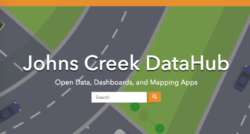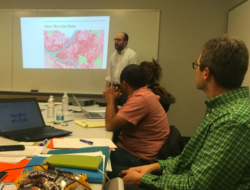How small cities can do big things with open data
I recently wrote about the Hometown Summit, an event bringing together leaders in government, academia, private and nonprofit organizations from small cities across the country, to discuss the strategies they’re using to target community challenges. The conversations I had at the conference inspired me to take a step back and think through tactics that cities with fewer resources and residents can use to build an open data program.
As the What Works Cities (WWC) initiative broadens its reach with the new Certification Program, which is available to cities with populations as low as 30,000, I’m looking forward to seeing more small cities gain recognition for their efforts to expand the use of data in their communities. Below is a list of strategies that smaller cities can use to get started.
Leverage community resources
No capacity to provide training to data users? Need help building a data visualization to illustrate an issue you identified using open data? Want to communicate to residents that your city is building an open data program?
Working with those outside government is always key to carrying out a successful open data program. In cities with fewer internal resources, it becomes increasingly important to leverage the power of your community, borrowing tools and volunteers from local businesses, nonprofits, the media, and schools to achieve your open data goals.
 There is great value for smaller cities in cultivating partnerships outside of government. The small city of Johns Creek, GA, for example, kicked off its open data program by partnering with Waze, a community based traffic and navigation app, to help drivers navigate around road closures and find the best routes for avoiding traffic.
There is great value for smaller cities in cultivating partnerships outside of government. The small city of Johns Creek, GA, for example, kicked off its open data program by partnering with Waze, a community based traffic and navigation app, to help drivers navigate around road closures and find the best routes for avoiding traffic.
If you’re looking for ideas, the GovLab shared some tips for reaching out to these similar data collaboratives.
Support from city leadership is key
In smaller cities with fewer resources, support from city councils, mayors, city managers, and other internal leadership can be key to establishing and sustaining a successful open data program. Take Hartford, CT, for example. The city was constrained in some ways by a small population and a limited budget, but a strong executive order issued by the mayor cleared the way for the city’s participation in the open data movement. With clear mandates for timelines, implementation steps, and monitoring, the order allowed the team working on the open data program to build it up from scratch in just months.
If you’re not sure where to get started with a policy, Sunlight’s Public Policy for Public Data website will walk you through the entire process.
Meet people where they are
When it comes to engaging residents in any city, it’s important to meet residents where they are. This is especially true when it comes to open data.
Not everyone has the tech skills to work with data, especially in smaller cities, nor is everyone going to know what you mean when you say “open data.” Just as important, tech-savvy residents won’t have all the insights and expertise needed to take on every issue – or even most issues. Work toward equity in your open data program by involving non-technical members of your community in other ways. Understand the issues they care about to inform your metrics and data collection. Open data is a two-way street.

Find the right vehicles to reach people, whether through a phone call, a paper survey, a website, text message, a billboard, an email, or a community event. Get creative. As one Hometown Summit attendee from New Orleans put it, “People won’t tell you much online, but they sure will come around and talk if you offer them free food.”
In cities of any size, it’s critical that insights are gathered from all residents to inform your open data program. Plus, you’re much more likely to build trust and gain participation if you can show residents you took the time to incorporate their feedback.
Use peer networks
Learn from the successes and setbacks of other small cities. Take advantage of opportunities to network with open data leaders from other cities at conferences such as the Hometown Summit. There’s no need to reinvent the wheel when something is already working.

Sunlight has worked with several smaller cities who have found alternatives to procuring a fancy, top-of-the-line open data portal by taking advantage of in-house expertise to build their own using existing web-based open source data management systems, such as CKAN. And through the What Works Cities Certification program, you’ll be able to follow the great work of cities of all sizes.
Steal a page out of our Tactical Data Engagement Guide
Sunlight’s new Tactical Data Engagement Guide features many different problem framing and action tactics for engaging residents in your open data program. The best part? These strategies are completely flexible so you can adapt them to work for a city of any size.
Don’t be afraid to fail
If the first strategy you use to engage your community around your new open data program doesn’t work, try again! As is key to the guide I mentioned above, you should continue iterating on your engagement processes to ultimately figure out what works. Don’t be afraid to take risks.
Do you know of a small city doing big things with open data? Let us know by emailing local@sunlightfoundation.com! We encourage them to participate in the WWC Certification program. We’re excited to be able to better track and celebrate the open data progress in smaller U.S. cities.

